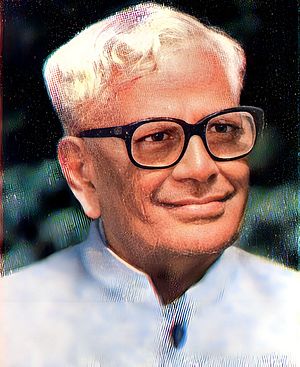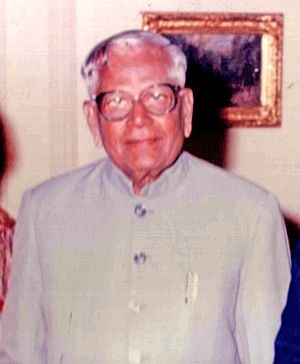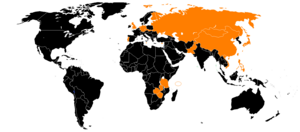Ramaswamy Venkataraman facts for kids
Quick facts for kids
Ramaswamy Venkataraman
|
|
|---|---|
 |
|
| 8th President of India | |
| In office 25 July 1987 – 25 July 1992 |
|
| Prime Minister | Rajiv Gandhi V. P. Singh Chandra Shekhar P. V. Narasimha Rao |
| Vice President | Shankar Dayal Sharma |
| Preceded by | Zail Singh |
| Succeeded by | Shankar Dayal Sharma |
| 7th Vice President of India | |
| In office 31 August 1984 – 24 July 1987 |
|
| President | Zail Singh |
| Prime Minister | Indira Gandhi Rajiv Gandhi |
| Preceded by | Mohammad Hidayatullah |
| Succeeded by | Shankar Dayal Sharma |
| Minister of Home Affairs | |
| In office 22 June 1982 – 2 September 1982 |
|
| Prime Minister | Indira Gandhi |
| Preceded by | Zail Singh |
| Succeeded by | Prakash Chandra Sethi |
| Minister of Defence | |
| In office 15 January 1982 – 2 August 1984 |
|
| Prime Minister | Indira Gandhi |
| Preceded by | Indira Gandhi |
| Succeeded by | Shankarrao Chavan |
| Minister of Finance | |
| In office 14 January 1980 – 15 January 1982 |
|
| Prime Minister | Indira Gandhi |
| Preceded by | Hemvati Nandan Bahuguna |
| Succeeded by | Pranab Mukherjee |
| Personal details | |
| Born | 4 December 1910 Rajamadam, Madras, British India (now Tamil Nadu, India) |
| Died | 27 January 2009 (aged 98) New Delhi, Delhi, India |
| Political party | Indian National Congress |
| Spouse | Janaki Venkataraman |
| Children | 3 |
| Alma mater | Loyola College, University of Madras |
| Profession | |
| Signature |  |
Ramaswamy Venkataraman (born December 4, 1910 – died January 27, 2009) was an important Indian leader. He was a lawyer and a freedom fighter who helped India become independent. Later, he became a Union Minister and served as the eighth President of India.
Venkataraman was born in a village called Rajamadam in the Tanjore district of Madras Presidency. He studied law and worked as a lawyer in the Madras High Court and the Supreme Court of India. When he was young, he was very active in the Indian independence movement. He even took part in the Quit India Movement, which was a big protest against British rule.
He was chosen to be a member of the group that wrote India's Constitution. He also served in the first Indian Parliament. He was elected to the Lok Sabha (India's main Parliament house) four times. During his career, he held important jobs like Union Finance Minister and Defence Minister. In 1984, he became the seventh Vice President of India. Then, in 1987, he became the eighth President of India, serving until 1992. He also worked as a state minister in Madras.
Contents
Early Life and Education
Ramaswamy Venkataraman was born in Rajamadam village, near Pattukottai in Tamil Nadu. This was during the time when India was ruled by the British. He went to school in Pattukottai and then studied at National College, Tiruchirappalli.
He continued his studies in Chennai (which was then called Madras). He earned a master's degree in economics from Loyola College, Chennai. After that, he studied law at the Law College in Madras. He became a lawyer in the Madras High Court in 1935 and later in the Supreme Court of India in 1951.
Fighting for Freedom
While working as a lawyer, Venkataraman became deeply involved in India's fight for freedom from British rule. He actively joined the Indian National Congress in their protests. His strong involvement in the Quit India Movement in 1942 led to him being held by the British for two years.
Even during this time, he kept his interest in law. In 1946, when India was about to gain independence, the Indian government sent him to Malaya and Singapore. His job was to defend Indian people who were accused of working with the Japanese during World War II. From 1947 to 1950, he was the Secretary of the Madras Provincial Bar Federation.
Political Journey
Venkataraman's work in law and trade led him more and more into politics. He was a member of the group that created India's constitution. In 1950, he was elected to India's first Parliament. He served there from 1950 to 1957. During this time, he also represented Indian workers at an international meeting in 1952.
Even though he was re-elected to Parliament in 1957, Venkataraman decided to leave his seat. He joined the state government of Madras (now Tamil Nadu) as a minister. From 1957 to 1967, he managed important areas like Industries, Labour, Power, and Transport. He was also the leader of the Madras Legislative Council.
Key Roles as a Union Minister
In 1967, Venkataraman became a member of the Union Planning Commission. This group plans how the country will develop. He was in charge of areas like Industry, Labour, and Transport until 1971. In 1977, he was elected to the Lok Sabha again. He served as an opposition member and led the Public Accounts Committee, which checks government spending.
Venkataraman also held many other important positions. He was part of key government committees dealing with politics and economics. He served as a Governor for international financial organizations like the International Monetary Fund and the Asian Development Bank. He represented India at the United Nations General Assembly several times. He also led India's team at the International Labour Conference in Geneva in 1958. From 1955 to 1979, he was a member of the United Nations Administrative Tribunal, even serving as its President for many years.
Leading India's Defence
In 1980, Venkataraman was re-elected to the Lok Sabha. He was then made the Union Minister of Finance under Prime Minister Indira Gandhi. Later, he became the Union Minister of Defence. He is known for starting India's missile program. He moved a brilliant scientist, A. P. J. Abdul Kalam, from the space program to the missile program. He helped bring together all the missile development efforts, creating the Integrated Guided Missile Development Program.
Vice President and President of India
| Presidential styles of Ramaswamy Venkataraman |
|
|---|---|
  |
|
| Spoken style | President R. Venkataraman |
| Alternative style | Mr. President |
After his time as Defence Minister, Ramaswamy Venkataraman became the Vice President of India. Then, in 1987, he became the President of India. During his five-year term as President, he worked with four different prime ministers. He even appointed three of them: V. P. Singh, Chandra Shekhar, and P. V. Narasimha Rao. This period was important because it saw the beginning of coalition politics in India, where different parties work together to form a government.
Awards and Recognition
Venkataraman received many honors for his contributions. He was given honorary law degrees from the University of Madras and the University of Burdwan. He also received a Doctor of Social Sciences degree. He was honored with the Tamra Patra for his role in the freedom struggle. He also received the Soviet Land Prize for a book he wrote about K. Kamaraj's visit to socialist countries. The Secretary-General of the United Nations also gave him an award for his excellent service as President of the U.N. Administrative Tribunal.
Later Years and Passing
On January 12, 2009, Venkataraman was admitted to the Army Hospital in New Delhi. He had an infection. His health became very serious on January 20.
Ramaswamy Venkataraman passed away on January 27, 2009, at the age of 98, due to organ failure. Because he died the day after Republic Day, some celebrations were cancelled to show respect. He was cremated with full state honors at Ekta Sthal, near Raj Ghat. Many important leaders, including President Pratibha Patil and Prime Minister Manmohan Singh, expressed their sadness at his death.
Books by R. Venkataraman
- Role of Planning in Industrial Development, 1969.
- The Role of a Private Member of Parliament, 1986.
- My Presidential Years – R Venkataraman, 1995.
- R. Venkataraman on Contemporary Issues, 1996.
- Relevance of Gandhi: And Other Essays, 1998.
Books About R. Venkataraman
- President R. Venkataraman, by Nand Gopal Chaudhry, 1987.
- The Great Humanist Ramaswami Venkataraman, by Attar Chand, 1987.
- So May India be Great: Selected Speeches and Writings of President R. Venkataraman, 1990.
- Selected Speeches, 1984–87, 1991.
- President R. Venkataraman Selected Speeches: July 1987 – December 1989, 1991.



